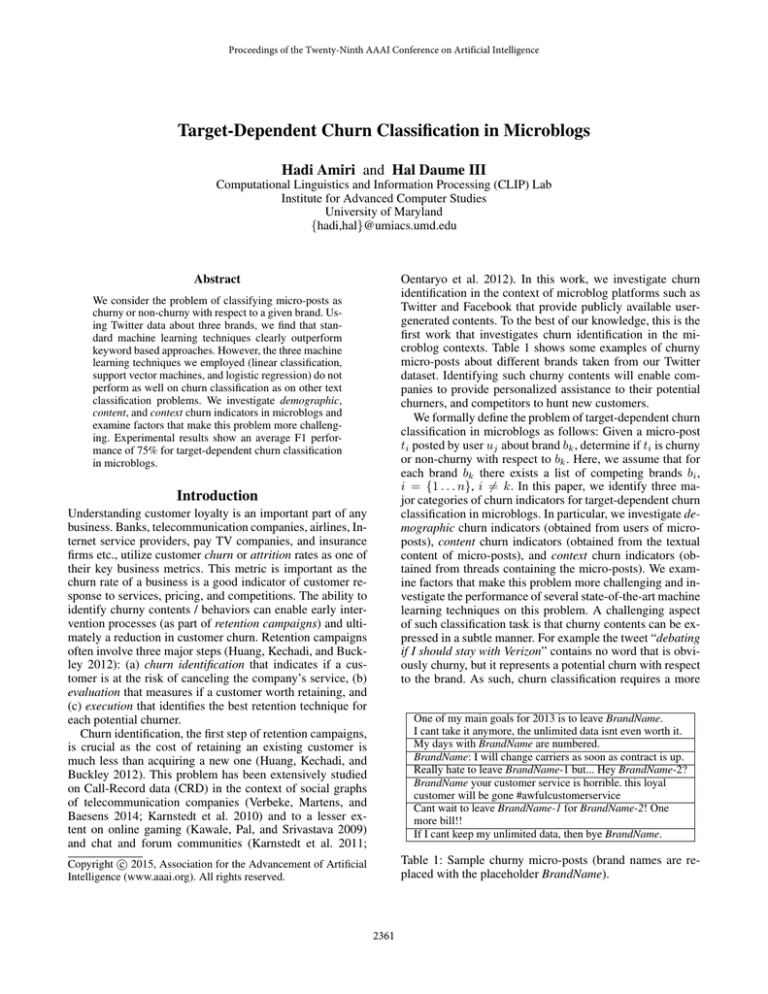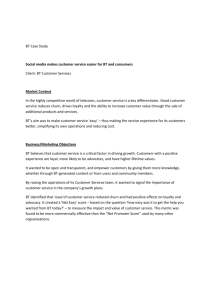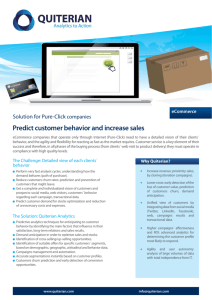
Proceedings of the Twenty-Ninth AAAI Conference on Artificial Intelligence
Target-Dependent Churn Classification in Microblogs
Hadi Amiri and Hal Daume III
Computational Linguistics and Information Processing (CLIP) Lab
Institute for Advanced Computer Studies
University of Maryland
{hadi,hal}@umiacs.umd.edu
Abstract
Oentaryo et al. 2012). In this work, we investigate churn
identification in the context of microblog platforms such as
Twitter and Facebook that provide publicly available usergenerated contents. To the best of our knowledge, this is the
first work that investigates churn identification in the microblog contexts. Table 1 shows some examples of churny
micro-posts about different brands taken from our Twitter
dataset. Identifying such churny contents will enable companies to provide personalized assistance to their potential
churners, and competitors to hunt new customers.
We formally define the problem of target-dependent churn
classification in microblogs as follows: Given a micro-post
ti posted by user uj about brand bk , determine if ti is churny
or non-churny with respect to bk . Here, we assume that for
each brand bk there exists a list of competing brands bi ,
i = {1 . . . n}, i 6= k. In this paper, we identify three major categories of churn indicators for target-dependent churn
classification in microblogs. In particular, we investigate demographic churn indicators (obtained from users of microposts), content churn indicators (obtained from the textual
content of micro-posts), and context churn indicators (obtained from threads containing the micro-posts). We examine factors that make this problem more challenging and investigate the performance of several state-of-the-art machine
learning techniques on this problem. A challenging aspect
of such classification task is that churny contents can be expressed in a subtle manner. For example the tweet “debating
if I should stay with Verizon” contains no word that is obviously churny, but it represents a potential churn with respect
to the brand. As such, churn classification requires a more
We consider the problem of classifying micro-posts as
churny or non-churny with respect to a given brand. Using Twitter data about three brands, we find that standard machine learning techniques clearly outperform
keyword based approaches. However, the three machine
learning techniques we employed (linear classification,
support vector machines, and logistic regression) do not
perform as well on churn classification as on other text
classification problems. We investigate demographic,
content, and context churn indicators in microblogs and
examine factors that make this problem more challenging. Experimental results show an average F1 performance of 75% for target-dependent churn classification
in microblogs.
Introduction
Understanding customer loyalty is an important part of any
business. Banks, telecommunication companies, airlines, Internet service providers, pay TV companies, and insurance
firms etc., utilize customer churn or attrition rates as one of
their key business metrics. This metric is important as the
churn rate of a business is a good indicator of customer response to services, pricing, and competitions. The ability to
identify churny contents / behaviors can enable early intervention processes (as part of retention campaigns) and ultimately a reduction in customer churn. Retention campaigns
often involve three major steps (Huang, Kechadi, and Buckley 2012): (a) churn identification that indicates if a customer is at the risk of canceling the company’s service, (b)
evaluation that measures if a customer worth retaining, and
(c) execution that identifies the best retention technique for
each potential churner.
Churn identification, the first step of retention campaigns,
is crucial as the cost of retaining an existing customer is
much less than acquiring a new one (Huang, Kechadi, and
Buckley 2012). This problem has been extensively studied
on Call-Record data (CRD) in the context of social graphs
of telecommunication companies (Verbeke, Martens, and
Baesens 2014; Karnstedt et al. 2010) and to a lesser extent on online gaming (Kawale, Pal, and Srivastava 2009)
and chat and forum communities (Karnstedt et al. 2011;
One of my main goals for 2013 is to leave BrandName.
I cant take it anymore, the unlimited data isnt even worth it.
My days with BrandName are numbered.
BrandName: I will change carriers as soon as contract is up.
Really hate to leave BrandName-1 but... Hey BrandName-2?
BrandName your customer service is horrible. this loyal
customer will be gone #awfulcustomerservice
Cant wait to leave BrandName-1 for BrandName-2! One
more bill!!
If I cant keep my unlimited data, then bye BrandName.
Table 1: Sample churny micro-posts (brand names are replaced with the placeholder BrandName).
c 2015, Association for the Advancement of Artificial
Copyright Intelligence (www.aaai.org). All rights reserved.
2361
Brand
Verizon
T-Mobile
AT&T
solid understanding of the natural language.
We conduct experiments on a Twitter dataset created from
a large number of tweets about three telecommunication
brands. Experimental results show an average F1 performance of 75% for target-dependent churn classification in
microblogs. Our dataset is available at www.umiacs.umd.
edu/∼hadi/chData.
Churny
447
95
402
Non-churny
1543
978
1389
P+
36.5
39.0
35.4
R+
74.7
79.5
81.4
F1+
48.9
50.1
48.4
Table 2: Performance of the rule-based churn classifier for
three brands. Churny and Non-churny columns show the
number of churny and non-churny micro-posts for each
brand respectively.
Preliminary Analysis
In churn classification, one may suspect that there are certain
words that can be used to express churny contents. Therefore, it might be enough to produce such a list of keywords
and rely on them alone to classify micro-posts as churny or
non-churny. To test this hypothesis, we manually created a
list of 50 potential churny terms and phrases1 based on a preliminary examination of our twitter dataset (see Section 4)
and Wordnet synonyms. We then designed a rule-based classifier that labels micro-posts as churny or non-churny with
respect to a target brand based on the presence or absence of
such keywords (along with the brand name) in micro-posts
respectively. Table shows the performance of the rule-based
classifier on the positive (churn) class based on the standard
precision, recall, and F1-score measures.
As the results show, the rule-based classifier has a very
low precision and therefore low F1 performance2 . Our closer
look at the data reveals five major reasons that lead to the
poor performance of the rule-based classifier:
First, there exist comparative micro-posts in which users
compare two / several brands against each other and express
their intention about leaving one brand for another. Such
micro-posts are only churny with respect to one brand but
not the others. However, the rule-based classifier labels the
micro-posts regardless of any target brand. This greatly reduces the performance of the classifier.
Second, simple language constituents such as prepositions are important in accurate classification of micro-posts
with respect to target brands. For example, prepositions like
“to” and “from” can simply reverse the class of a micropost with respect to a brand, compare phrases like “switch
to BrandName” vs. “switch from BrandName”. These important indicators are simply ignored by the rule-based classifier.
Third, negation has an important contextual effect on
churn classification. It can simply reverse the label of a
micro-posts. For example, the rule-based classifier will mistakenly label the micro-post “BrandName is awesome, I’ll
never leave them” as churny with respect to the brand.
Fourth, the presence of a churny keyword does not necessarily convey churny contents. For example, the micro-posts
“BrandName-1 to give BrandName-2 customers up to $450
to switch” or “ I need a little BrandName’s #help b4 leaving
the states” contain the terms “switch” and “leaving” respectively, but they are not churny with respect to the brands.
Finally, churny contents can be expressed in subtle ways
as in “debating if I should stay with BrandName” or “in 2
months, bye BrandName” that contain no obvious churny
keywords but clearly express churny contents with respect to
the brand. Such micro-posts are simply missed by the rulebased classifier.
We conclude from these preliminary experiments that it
is worthwhile to explore the major indicators for targetdependent churn classification in microblogs. We introduce
these indicators in the subsequent Sections.
Churn Indicators in Microblogs
We introduce three categories of churn indicators for targetdependent churn classification in microblogs.
Demographic Churn Indicators
Demographic features contain user-specific information that
can help classifiers to learn churn classification based on
user profiles. These features are shown in Table 3 and are
expected to provide useful signals to learn churn classification. For example, if a user is not active with respect to
any competitors, then he is less likely to send churny contents about a target brand, or users who often share URLs
are more likely news agencies or brand sale representatives
who almost never send churny contents about brands. Here,
we define an active day as a day in which the user sends at
least one micro-post about the target brand. We also compute
the average friend activity ratios for each user to account for
the social influence on his behavior. Furthermore, we take
into account information like number of friends, followers
and etc that have been shown to be highly useful for churn
classification on forum and call record data (Karnstedt et al.
2011).
Content Churn Indicators
Content Features represent semantic information extracted
from the content of micro-posts. These features are shown
in Table 4. N-gram features are usually employed by corpusbased techniques and have been shown to be useful for various text classification problems. In addition to the n-gram
features, we find that the neighboring words of brand names
in micro-posts often contain rich contextual information for
churn classification. We capture the effect of the neighboring
words of brand / competitors by considering 2k features representing the left and right k neighboring words of the brand,
and 2k features representing the left and right k neighboring
1
Sample set of churny keywords used: {leave, leaving, switch,
switching, numbered, cancel, canceling, discontinue, give up, call
off, through with, get rid, end contract, change to, changing, . . . }.
2
Later experiments using the churny keywords as features of
our classifiers did not yield to better results except with linear regression that yielded to a slightly better but still poor performance.
2362
Description
Activity ratio:
average No. of posts about brand/competitors per day
ratio of active days about brand/competitor
average time gap between posts about brand/competitor
ratio of urls in posts about brand/competitor
average No. of words in post about brand/competitor
Average of friends activity ratios
# followers and friends
If user has bio information
If bio contains URL
(a) syntactic features: {dobjleave-Brand,
nsubj-leave-i,
aux-leave-will}.
Table 3: Demographic indicators extracted from user / author profiles.
(b) syntactic features with negation
effect: {Neg-dobj-leave-Brand, Negnsubj-leave-i, Neg-aux-leave-will}
Description
Unigrams / Bigrams
Neighboring words of brand/competitors names
Syntactic and Comparative marker features
Sentiment features
Tense of tweet
News indicator features
Figure 1: Syntactic features extracted from micro-posts content by capturing the effect of negation. In Figure 1(b) the
verb leave is negated by the negation modifier never.
object dobj(leaving, BrandName-1) relations can be used to
determine the user as the subject and BrandName-1 as the
object of the post. These features together can capture the
effect of various language constituents in the micro-posts.
Table 4: Content indicators for churn classification. These
features will be extracted from the content of the target
micro-posts.
To deal with comparative micro-posts, we identify comparative markers. For this purpose, we utilize POS tag patterns (in particular comparative (JJR) and superlative (JJS)
adjectives) in conjunction with the dependency relations obtained from the syntactic parse trees of micro-posts. As an
example, in the micro-post “TargetBrand has better coverage than CompBrand”, the POS pattern “better/JJR */NN
than/IN” and the dependency relation “prep than(*, CompBrand)” can be used to capture comparative effects.
words of all competitors (in the experiments, we set k = 3
as it leads to superior performance).
In addition, we rely on syntactic parse trees to identify
expressions describing the target brand3 . In particular, for
any dependency relation reli , except the negation relation,
between the brand name and any word wj , we generate a
feature as “reli -wj -Brand” or “reli -Brand-wj ” depending on the role of brand as a governor or dependent in the
dependency relation. We also extract such features from the
dependency relations that contain a verb as their governor
or dependent. This is because verbs, especially action verbs,
capture most content information in sentences (Levin 1993).
To tackle with negations, if any word included in the resultant syntactic features is modified by a negation word,
we add a prefix “N eg−” to all its corresponding features.
Figures 1(a) and 1(b) show the syntactic features extracted
for the tweets “I will leave Brand” and “I will never leave
Brand” with the transitive verb “leave” respectively.
Furthermore, we observed that the prepositional, direct
object, and nominal subject dependency relations are the
main syntactic relations useful to capture the effect of simple language constituents. For example, in the tweet “I am
leaving BrandName-1 for BrandName-2”, the prepositional
dependency prep for(BrandName-1, BrandName-2)4 can be
used to determine that the churn is in favor of BrandName2, and the nominal subject nsubj(leaving,I) and the direct
Our analysis also shows that churny micro-posts may
carry strong negative sentiment toward the target brands.
To account for the sentiment effects, we consider two features indicating the number of positive or negative sentiment
terms that co-occur with the target brand in micro-posts. A
better approach to capture sentiment information is to obtain target-dependent sentiment score with respect to brands
as studied in (Jiang et al. 2011). The approach utilizes the
syntactic structure of micro-posts in conjunction with subjectivity clues and target dependent features to determine
the sentiment with respect to a given target. We leave this
analysis to the future work.
Furthermore, churny micro-posts are expected to have
present or future tense. To capture this information, we make
use of verb tenses (identified by their POS tag information)
and consider three features representing the number of verbs
with past, present, and future tenses available in micro-posts
respectively. We also observed that news-oriented microposts about brands often carry the brand name as their subject and usually contain a URL. To account for such effects,
we consider three binary features indicating if the target
brand is the (a) subject or (b) object of the micro-post, or
(c) if the tweet contains a URL respectively.
3
We used the Twitter POS tagger developed in (Owoputi et al.
2013) to POS tag micro-posts and then used the resultant POS
tagged micro-posts and Stanford parser to generate the parse trees.
4
The prepositional modifiers serves to modify the meaning of verbs, adjectives, nouns, or even other prepositions, e.g.
prep(switching, from)
2363
Description
Content features of user/friends/brand/competitors posts
in thread (as defined in Table 4)
# posts from user/friends/brand/competitors in thread
# posts in thread
Reciprocity between user and brand/competitors posts
Table 5: Context indicators for churn classification. These
features will be extracted from threads containing the target
micro-posts.
Churn Classification
We investigate the performance of three state-of-the-art classification approaches for churn classification in microblogs.
Given input micro-posts (x1 , x2 ,. . . , xn ) and their corresponding (churny, non-churny) labels (y1 , y2 ,. . . , yn ), yi ∈
{−1, +1}, the classification problem is to find a function
f (x) that minimizes:
L(x, y) =
n
X
l(yi , f (xi ))
(1)
i
where l(., .) represents the loss between the actual label
and its corresponding prediction. Loss functions are usually
functions that becomes close to zero when f (xi ) agrees in
sign with yi . We consider three loss functions here, the linear
loss (representing linear classification), the hinge loss (employed by the SVMs), and the logistic loss (representing logistic classifier) defined as follows respectively:
Figure 2: A thread containing a churny tweet with respect to
Verizon crawled from Twitter.
Context Churn Indicators
l(y, f (x)) = |y.f (x)|
l(y, f (x)) = max(0, 1 − y.f (x))
l(y, f (x)) = log(1 + exp(−y.f (x)))
Churny tweets may trigger discussions between users and
their friends as well as known accounts of brands. The
known-accounts of a brand are a few official accounts created on Twitter that either act as informers or provide various services to brand customers. These accounts are usually
well-publicized and easy to find. In fact, brands participate
in such discussions to retain their customers while competitors intervene to hunt new customers. Figure 2 shows a sample thread triggered by a churny tweet.
We expect thread information to be useful for churn classification as threads provide context information about target
micro-posts. Table 5 shows churn indicators that can be extracted from threads. We extract content features (as shown
in Table 4) for each micro-post in the thread. To distinguish
the content generated by different parties in threads, we put
the features into different namespaces by adding “USer-”,
“FRiend-”, “BRand-”, and “COmp-” prefixes to the content
features extracted from user, friend, target brand, and competitor microposts respectively. Furthermore, reciprocity between user and brand posts (the time difference between the
target micro-post, i.e. the classification input, and the first
response from the brand) could be a good indicator of churn
as we observed that brands respond to churny micro-posts
more quickly than non-churny ones. Also, we compute reciprocity between user and competitors as the time difference
between the target micro-post and the earliest response from
any competitors.
We employ Vowpal Wabbit classification toolkit5 with all
parameters set to their default values to perform the classification experiments.
Data and Settings
We collect twitter data for three telecommunication brands,
namely Verizon6 , T-Mobile7 , and AT&T 8 . To obtain a development dataset, we crawled tweets that contained the
name of the above brands or were posted by the knownaccounts (see Section “Context Churn Indicators”) of the
above brands using the streaming API of twitter for a period of six months. As the pre-processing step, we converted
all the tweets into lower-case terms and removed those with
less than three words.
The resultant dataset contains a highly imbalanced data
distribution in terms of churny vs non-churny tweets. To create our gold-standard dataset, we first clustered the tweets
into a chosen number of clusters and then, within each cluster, we further categorized tweets into sub-clusters using our
5
http://hunch.net/ vw/
https://twitter.com/VerizonSupport
7
https://twitter.com/TMobileHelp
8
https://twitter.com/ATTCustomerCare
6
2364
(1)
(2)
Features
Unigram
base:Uni+bigram
(3)
base+Content
(4)
base+Demog.
(5)
base+Context
(6)
All
classic
56.5
67.1
73.4*
(6.3)
68.5
(1.4)
71.1*
(4.0)
72.8*
(5.7)
Verizon
hinge
60.1
72.8
75.4*
(2.6)
73.4
(0.6)
73.8*
(1.0)
76.8*
(4.0)
logistic
59.6
69.9
73.8*
(3.9)
70.9
(1.0)
72.0*
(2.1)
75.4*
(5.5)
classic
63.5
67.3
68.3*
(1.0)
67.6
(0.3)
65.0*
(-2.3)
70.3*
(2.9)
T-Mobile
hinge
64.4
65.9
68.1*
(2.2)
69.6*
(3.7)
70.5*
(4.6)
70.2*
(4.3)
logistic
66.1
69.8
70.6*
(0.8)
68.9
(-0.9)
70.0*
(0.2)
74.4*
(4.7)
classic
62.2
74.6
75.4*
(0.8)
74.8
(0.2)
77.4*
(2.8)
78.2*
(3.7)
AT&T
hinge
66.3
74.9
77.7*
(2.8)
76.5*
(1.6)
77.0*
(2.1)
80.0*
(5.0)
logistic
67.2
75.4
78.5*
(3.1)
75.7
(0.3)
77.8*
(2.4)
78.5*
(3.1)
Table 6: F1 Performance of target-dependent churn classification based on different indicators evaluated over three brands.
Values in parenthesis show F1 improvement over the baseline, base:Uni+bigram.
manually created list of potential churny terms. We then randomly sampled data from all these clusters (including those
that do not contain any churny keywords) for manual annotation. The first round of clustering helps to tackle data
redundancy, while the second round helps to capture a fair
distribution of churny tweets. We emphasize that learning
churn classification is independent of this clustering step as
each sub-cluster may contain both positive and negative examples (see “preliminary analysis” Section).
We asked three annotators to manually label the resultant
tweets as churny or non-churny with respect to each target brand. Finally we obtained 447 and 1543 churny and
non-churny tweets for Verizon, 95 and 978 churny and nonchurny tweets for T-mobile, and 402 and 1389 churny and
non-churny tweets for AT&T9 . We weight the positive examples by the ratio of negative to positive examples to deal
with imbalanced classification input.
Inter-annotator agreement is computed based on Fleiss’
kappa measure (Fleiss 1971). This measure is computed
over all the instances labeled by three annotators: the resultant κ value is 0.62 that indicates substantial agreement
among annotators (Fleiss 1971). We also report Cohen’s
kappa value computed over 1073 instances related to Tmobile that were independently labeled by the first author
of this paper and compared against the aggregation of the
three annotators judgments over these instances. The resultant Cohen’s kappa value is 0.93 that indicates substantial
annotation agreement as well (note that the above two κ values are not directly comparable).
line for this task (note that ngram models lead to relatively
good performance on various text classification problems).
We experimented with ngrams (n={1. . . 3}) and their combination both at the word and character levels. We found that
the combination of unigrams and bigrams at the word level
leads to the best performance. As such we considered this
setting as the baseline for this task.
Table shows the F1 Performance based on different indicators evaluated over three brands. Row (2) shows that the
combination of unigrams and bigrams greatly improves the
performance over unigrams. Row (3) shows that the content indicators (see Table 4) significantly improve the performance over the baseline for all brands and through all the
three classic, hinge, and logistic classifiers. Similarly row
(5) shows that adding the context indicators (see Table 5) to
the baseline features almost always significantly improve the
performance except in the case of liner classifier on T-mobile
data that results in a comparable performance. The results
also show that, although adding demographic features (see
Table 3) slightly improve the baseline, the difference is not
often significant. We correlate this to the very complex patterns of user activities in social media that are often difficult
to capture.
Table at row (6) shows that combining all the demographic, content, and context features together significantly
improve the performance over the baseline. However, it does
not lead to the best results in only two cases (see the performance of classic and hinge models at rows (3) and (5) for
Verizon and T-Mobile respectively), as highlighted in Table .
This motivated us to conduct an ablation study to investigate the effect of different indicators on target-specific churn
classification in microblogs. In the subsequent Sections, we
consider the hinge and logistic models for ablations analysis
of content and context indicators and report the average F1
performance over the three brands.
Results
In the experiments, we report the classification performance
(F1-score) over the churn class. We performed all the experiments through 10-fold cross validation and used the
two-tailed paired t-test ρ < 0.01 for significance testing.
Throughout this Section, we use the asterisk mark (*) to indicate significant improvement over the baseline.
Since there is no previous work on churn classification in
microblogs, we resort to n-gram models to determine a base9
Ablation Analysis of Content Chrun Indicators
Table shows the results of our ablation experiments
with content indicators. “Content” shows the average performance when we only use content features.
To conduct the ablation study we remove neighbor-
Available at www.umiacs.umd.edu/∼hadi/chData
2365
Features
base:Uni+bigram
Content
Content−Nighbr
Content−SynComp
Content−STN
Hinge
71.2
73.7
72.3 (−1.4)
73.4 (−0.3)
75.0 (+1.3)
Logistic
71.7
74.3
73.3 (−1.0)
73.4 (−0.9)
74.6 (+0.3)
Selected Features
base:Uni+bigram
All
All−STN
All−friend
All−STN−friend
Table 7: Ablation analysis of content-specific indicators. F1
values are averaged over three brands.
Features
base:Uni+bigram
base+Context
base+Context−user
base+Context−friend
base+Context−competitor
base+Context−brand
Hinge
71.2
73.8
71.9 (−1.9)
75.0 (+1.2)
74.4 (+0.6)
74.5 (+0.7)
Hinge
71.2
75.7
76.1 (+0.4)
76.3 (+0.6)
76.1 (+0.4)
Logistic
71.7
76.1
75.8 (−0.3)
76.1 (0.0)
75.8 (−0.3)
Table 9: Ablation analysis of selected churn indicators. F1
values are averaged over three brands.
Logistic
71.7
73.3
72.3 (−1.0)
73.4 (+0.1)
73.1 (−0.2)
73.1 (−0.2)
the Verizon data. The top three most demographic indicatives are in order (1) average friend active days about competitors, (2) average friend posts about competitors, and (3)
average friend active days about brand. The corresponding
content indicatives are in order (1) OBject=verizon where
verizon is the object of the micro-post, (2) “L1=leaving”
where L1 is the first left neighboring word of brand as in
I am leaving Verizon), and (3) “poss contract my” that indicates the possession modifier syntactic relation between
the words “my” and “contract” as in “my contract is over”.
The corresponding context indicatives are all from user
posts in threads and are in order (1) “USer leaving”, (2)
“USer contract”, and (3) “USer dobj leave verizon” that indicates direct object relation between the transitive verb
“leave” and the brand as in “I want to leave Verizon”).
Table 8: Ablation analysis of context-specific indicators. F1
values are averaged over three brands.
ing words (Content−Nighbr), syntactic and comparative
(Content−SynComp), as well as sentiment, tense, and news
indicator (Content−STN) features from the content features
and report the average performance over the three brands.
As Table shows, neighboring words as well as syntactic
and comparative features are important indicators as their
removal reduces the average F1 performance. However, removing sentiment and tense features improves the performance but not significantly. Note that, the sentiment features
may not accurately capture the sentiment with respect to the
target brand mainly due to the negation effect. Also, as for
the tense features, our observation shows that the majority
of micro-posts have a present or future tense and as such,
in contrast to our expectation, this feature may not be effective for churn classification. Table shows that removing the
STN features from the combination of all features leads to a
comparable performance with no significant change.
Related Work
Despite the numerous applications of user retention and the
availability of public user generated contents in microblogs,
target-specific churn classification appears to be underexplored in microblogs. The majority of previous works extensively studied churn classification on Call-Record data
(CRD) in the context of social graphs (Verbeke, Martens,
and Baesens 2014; Huang, Kechadi, and Buckley 2012;
Karnstedt et al. 2010) and to a lesser extent on online gaming (Kawale, Pal, and Srivastava 2009) and chat / forum
communities (Karnstedt et al. 2011; Oentaryo et al. 2012;
Patil et al. 2013). Research on CRD, utilized various indicators including user information such as age, gender, bill
frequency, account balance, outstanding charges, and call
details such as call duration, prices and fees etc, as well
as historical information of bills and payments, and social
relations based on incoming / outgoing calls. Churn classification in the game and forum domains also utilized various user-specific features such as age and gender as well as
features obtained from social relations among people. Recently (Dave et al. 2013) presented a churn classifier for recommender systems. The approach utilizes user-specific features such as user ratings and the time that users spend on
items to predict churn in recommender systems.
To the best of our knowledge, churn classification has
been unexplored in microblogs. However, microblog platforms provide publicly available user-generated contents
about different aspects of brands that can be effectively utilized to identify potential churners. In this work, we utilized such contents as well as other social signals for targetdependent churn classification in microblogs.
Ablation Analysis of Context Churn Indicators
In this experiments, we evaluate the effect of different parties contributing to threads (users, friends, brands, and competitors) on the churn classification performance. Table 8
shows the results of our ablation experiments.
As the results show, if we remove the context features that were obtained from users activities in the thread,
i.e. (base+Context−user), the performance significantly reduces as compared to when we use all such features
(base+Context). On the other hand, removing context features obtained from friends activities significantly improves
the performance. This suggests that friends activities in
threads might not be important for churn classification. We
also observed the same results by removing such features
from the combination of all features (see All−friend in Table ).
We also analyzed the correlation of different churn indicators with class labels based on Information Gain Ratio using
2366
Conclusion and Future Work
In this paper we investigate the problem of target-dependent
churn classification in microblogs. We study the most churn
indicatives in microblogs and examine factors that make this
problem more challenging. As our future work, we aim to
further investigate this problem from both content representation and social influence perspectives.
References
Dave, K. S.; Vaingankar, V.; Kolar, S.; and Varma, V. 2013.
Timespent based models for predicting user retention. In
Proceedings of WWW.
Fleiss, J. 1971. Measuring nominal scale agreement among
many raters. Psychological Bulletin 76(5):378–382.
Huang, B.; Kechadi, M. T.; and Buckley, B. 2012. Customer
churn prediction in telecommunications. Expert Syst. Appl.
39(1):1414–1425.
Jiang, L.; Yu, M.; Zhou, M.; Liu, X.; and Zhao, T. 2011.
Target-dependent twitter sentiment classification. In Proceedings of the 49th Annual Meeting of the Association for
Computational Linguistics: Human Language Technologies
- Volume 1, HLT ’11, 151–160. Stroudsburg, PA, USA: Association for Computational Linguistics.
Karnstedt, M.; Hennessy, T.; Chan, J.; Basuchowdhuri, P.;
Hayes, C.; and Strufe, T. 2010. Churn in social networks.
In Furht, B., ed., Handbook of Social Network Technologies
and Applications. Springer US.
Karnstedt, M.; Rowe, M.; Chan, J.; Alani, H.; and Hayes,
C. 2011. The effect of user features on churn in social networks. In Proceedings of Web Science. ACM.
Kawale, J.; Pal, A.; and Srivastava, J. 2009. Churn prediction in mmorpgs: A social influence based approach. In
Proceedings of International Conference on Computational
Science and Engineering. IEEE Computer Society.
Levin, B. 1993. English Verb Classes and Alternations: A
Preliminary Investigation. University of Chicago Press.
Oentaryo, R. J.; Lim, E.-P.; Lo, D.; Zhu, F.; and Prasetyo,
P. K. 2012. Collective churn prediction in social network.
In Proceedings International Conference on Advances in Social Networks Analysis and Mining.
Owoputi, O.; Dyer, C.; Gimpel, K.; Schneider, N.; and
Smith, N. A. 2013. Improved part-of-speech tagging for
online conversational text with word clusters. In Proceedings of NAACL.
Patil, A.; Liu, J.; Shen, J.; Brdiczka, O.; Gao, J.; and Hanley,
J. 2013. Modeling attrition in organizations from email
communication. In Social Computing (SocialCom).
Verbeke, W.; Martens, D.; and Baesens, B. 2014. Social network analysis for customer churn prediction. Applied Soft
Computing 14,C(0):431–446.
2367





